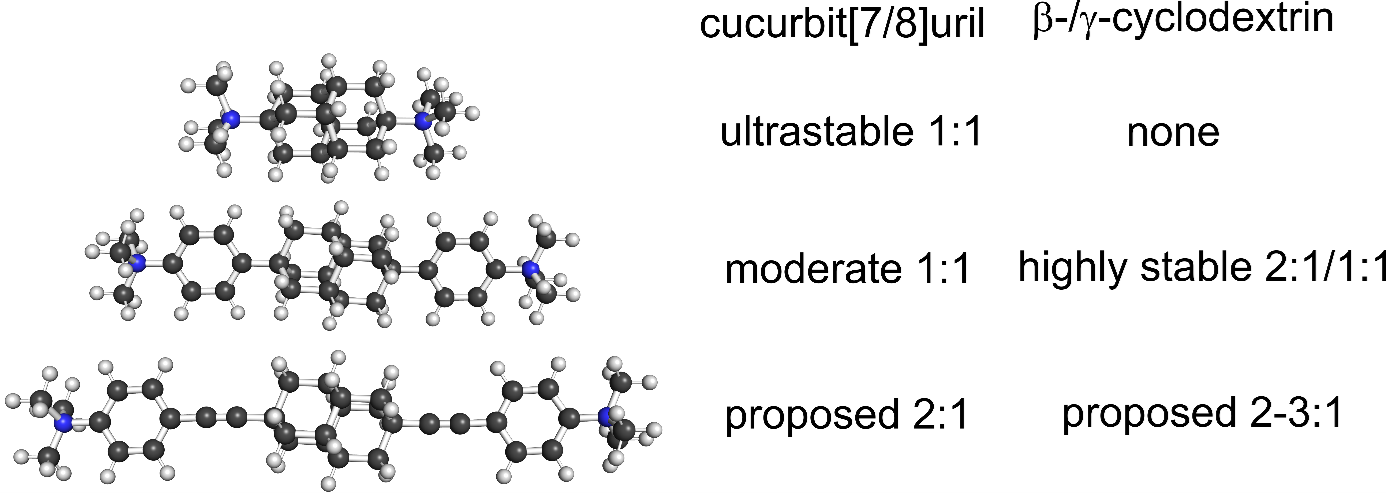Vícevazebné hostující molekuly na bázi diamantanové klece
| Téma: | Vícevazebné hostující molekuly na bázi diamantanové klece. |
| Topic: | Multitopic guests based on extended diamantane scaffold. |
| Školitel/Tutor: | doc. Mgr. Robert Vícha, Ph.D. |
| Konzultant/Consultant: | Ing. Petr Janovský, Ph.D. |
| E-mail: | rvicha@utb.cz; p_janovsky@utb.cz |
| Anotace: | |
| Diamantan je druhým členem homologické řady polymantanů. Všechny tyto látky představují fragment krystalové mřížky diamantu, což předurčuje některé jejich významné vlastnosti. Z hlediska supramolekulární chemie je důležitá rigidita těchto uhlovodíků, jejich chemická i termická stabilita a velmi nízká biologická aktivita. Proto se hodí jako základní stavební prvky pro konstrukci složitých hostujících molekul s mnoha vazebnými místy pro makrocyklické receptory. Tyto multikomponentní systémy pak nalézají uplatnění například jako nosiče léčiv, molekulární katalyzátory, přepínače, senzory či paměti. Zatímco jednoduché aminy odvozené od diamantanu extrémně pevně váží cucurbiturilové makrocykly vhodné velikosti, komplexy s cyklodextriny pozorovány nebyly. Předběžné výsledky naší výzkumné skupiny naznačují, že rozšíření diamantanové klece o další nepolární skupiny (fenyl) vede k dramatické změně vazebných možností (Obrázek). Cílem projektu bude navrhnout syntézu, postupně připravit a v reálných systémech s vhodnými makrocykly odzkoušet vazebnou kapacitu ligandů na bázi diamantanu rozšířeného o fenylethynyl motivy (Obrázek). Dalším logickým krokem bude syntéza složitějších hostujících molekul s tímto motivem a jejich studium v multikomponentních systémech. Hlavními metodami používanými ke studiu připravených systémů budou NMR, MS, ITC a monokrystalová RTG difrakční analýza. | |
| Annotation: | |
Diamantane is the second member of the homologous series of polymantanes. All of these substances represent a fragment of the diamond crystal lattice, which determines some of their significant properties. From the perspective of supramolecular chemistry, the rigidity of these hydrocarbons, their chemical and thermal stability, and their very low biological activity are important. Therefore, they are suitable as fundamental building blocks for the construction of complex guest molecules with many binding sites for macrocyclic receptors. These multicomponent systems then find applications, for example, as drug carriers, molecular catalysts, switches, sensors, or memories. While simple amines derived from diamantane bind cucurbituril macrocycles of the appropriate size extremely tightly, complexes with cyclodextrins have not been observed (see Figure). Preliminary results from our research group suggest that the expansion of the diamantane cage with additional nonpolar groups (phenyl) led to a dramatic change in binding possibilities (see Figure). The aim of the project will be to design a synthesis, gradually prepare, and test the binding capacity of diamantane-based ligands extended with phenylethynyl motifs in real systems with suitable macrocycles (see Figure). The next logical step will be the synthesis of more complex guest molecules with this motif and their study in multicomponent systems. The main methods used to study the prepared systems will be NMR, MS, ITC, and single-crystal X-ray diffraction analysis. |
|
| Požadavky na studenta: | |
| Znalost organické chemie na pokročilé úrovni; znalost fyzikální a analytické chemie na základní úrovni; znalost metod strukturní analýzy organických sloučenin (NMR, MS, IR); schopnost komunikovat jak písemně, tak ústně v anglickém jazyce. | |
| Requirements: | |
| Advanced knowledge of organic chemistry; basic knowledge of physical and analytical chemistry; ability to use spectral methods for structure determination of organic compounds (NMR, MS, IR); ability to fluently communicate orally and written in English.
|
|
| Literatura/Literature: | |
| 1) Cao, L.; Šekutor, M.; Zavalij, P. Y.; Mlinarić‐Majerski, K.; Glaser, R.; Isaacs, L. Angew. Chem. Int. Ed. 2014, 53, 988–993.
2) K. Jelínková, A. Závodná, J. Kaleta, F. Zatloukal, M. Nečas, Z. Prucková, L. Dastychová, M. Rouchal, R. Vícha: Two squares in a barrel: Axially disubstituted conformationally rigid aliphatic binding motif for cucurbit[6]uril. J. Org. Chem. 2023, 88, 15615–1625. 3) P. Branná, J. Černochová, M. Rouchal, P. Kulhánek, M. Babinský, R. Marek, M. Nečas, I. Kuřitka, R. Vícha: Cooperative binding of cucurbit[n]urils and b-cyclodextrin to ditopic imidazolium-based ligands. J. Org. Chem. 2016, 81, 9595–9604. 4) P. Branná, M. Rouchal, Z. Prucková, L. Dastychová, R. Lenobel, T. Pospíšil, K. Maláč, R. Vícha: Rotaxanes Capped with Host Molecules: Supramolecular Behavior of Adamantylated Bisimidazolium Salts Containing a Biphenyl Centerpiece. Chem. Eur. J. 2015, 21, 11712–11718. 5) K. I. Assaf, W. M. Nau: Cucurbiturils: from synthesis to high-affinity binding and catalysis. Chem. Soc. Rev. 2015, 44, 394–418. 6) S. J. Barrow, S. Kata, M. J. Rowland, J. del Barrio, O. A. Scherman: Cucurbituril-Based Molecular Recognition. Chem. Rev. 2015, 115, 12320–12406. 7) H. Wang, J. Mills, B. Sun, H. Cui: Therapeutic supramolecular polymers: Designs and applications Progress in Polymer Science 2024, 148, 101769. 8) M. Zhang, M. Kim, W. Choi, J. Choi, D. H. Kim, Y. Liu, Z. Lin: Chiral macromolecules and supramolecular assemblies: Synthesis, properties and applications Progress in Polymer Science 2024, 151,101800. 9) H.-Q. Peng, W. Zhu, W.-J. Guo, Q. Li, S. Ma, C. Bucher, B. Liu, X. Ji, F. Huang, J. L. Sessler: Supramolecular polymers: Recent advances based on the types of underlying interactions Progress in Polymer Science 2023, 137, 101635. |
|